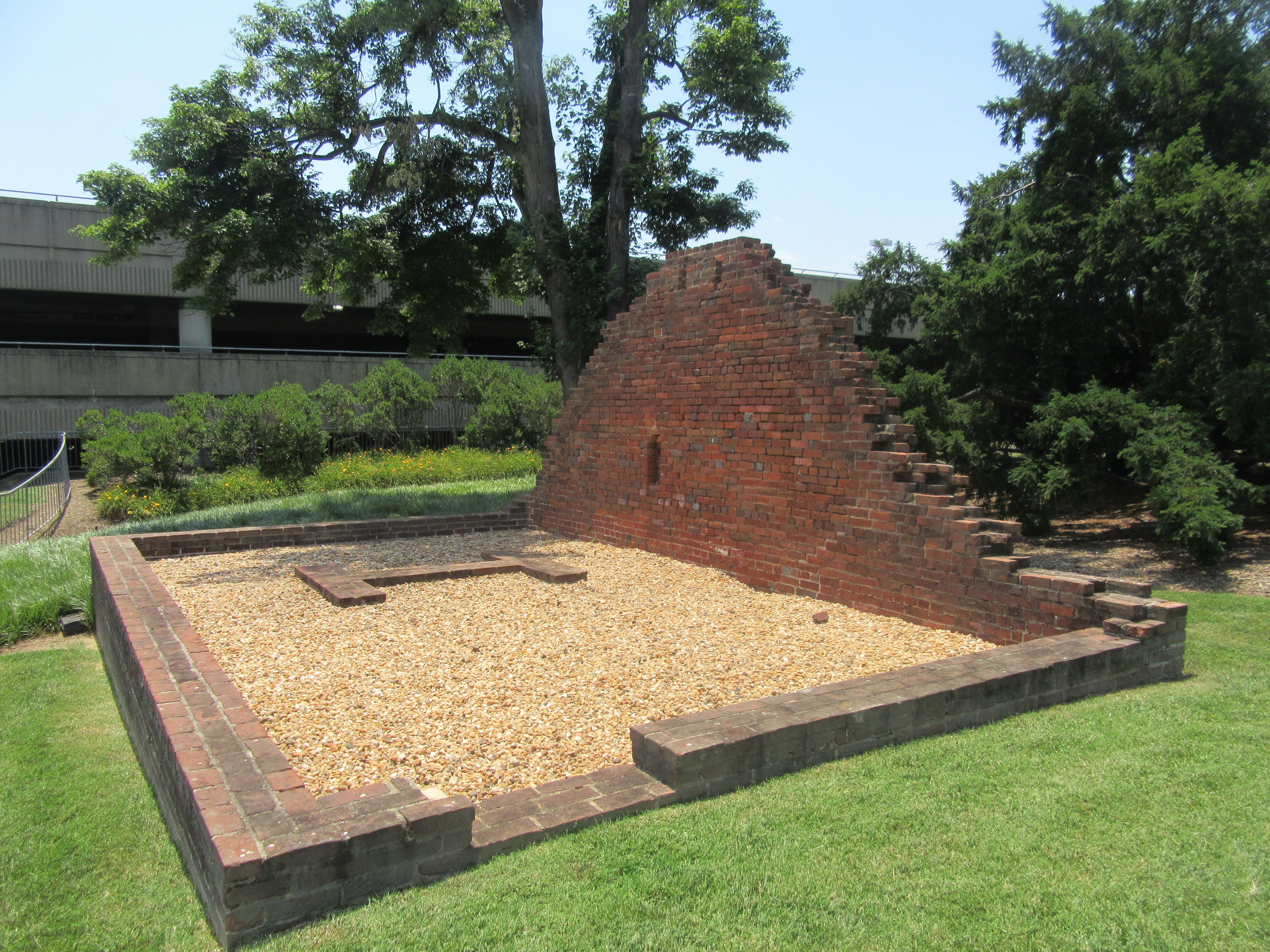For at least 7,000 years, people have used the land that is today’s sprawling 860-acre Reagan Washington National Airport, a complex of runways, roads, terminals, parking garages, vehicles, subway tracks and trains, airplane takeoffs and landings, and over 50 million passengers a year.
On June 17, airport officials spotlighted a group associated with the land but largely overlooked over time, the dozens of enslaved African and African-American people who toiled there when it was Abingdon Plantation. On a grassy knoll between garages 1 and 2, a triangular brick wall stretches to the sky, one remnant of this 18th and 19th century plantation and rarely noticed by harried travelers.

Today’s remains of the plantation’s kitchen and laundry.
As airplanes roared up and down and Metro trains rumbled by incessantly, officials cut a ribbon to unveil three new interpretive signs to honor people “previously unrecognized and highlight the enslaved population, a living part of Abingdon’s history,” said airport Acting Manager Chris Paolino. Many historic homes, especially plantations, have traditionally recognized only the white owners.
Paolino credited Dr. Thomas Foster, a Howard University history professor, with advocating for the new signage and conducting much of the research behind them. “The signs are an important step to a fuller history,” Foster stressed.
Paolino also highlighted Henry Ward, Assistant Vice President of Archaeology at WSP USA, for documenting the land’s history. Ward told visitors, “Indigenous people were here thousands of years and they still exist today. It is their land as well.” He described finding pottery sherds, an adze and shells likely from a nearby midden and used to make mortar. On Abingdon’s enslaved people, he noted, “The Black population always outnumbered the White population,” citing as examples, the Lee and Custis families.
“Our history has bright sides and dark sides. We must embrace it all.”
— Henry Ward, Assistant Vice President of Archaeology at WSP USA
The New Signs
A new sign at the entrance lists the known enslaved men and women of Abingdon by their first name only. “That’s all we had,” explained Ward, because few records were kept or survived. “They were considered like cattle,” he said, “listed in records with the livestock. An [enslaved] adult Black man was valued the same as a roan mare.”
A second sign tells the story of Charlotte, a seamstress, who in 1786 was accused and found innocent of stealing a white woman’s chintz dress. Charlotte had actually bought it from an enslaved man at Abingdon and altered it to her liking.
A third sign describes Peter Hardman, an enslaved stable manager and groom for the plantation’s 29 horses. Hardman helped George Washington cross two donkey breeds and bred male donkeys and female horses to produce the American mule, Ward reported.
Multiple Owners
In the 1600s, ship Captain Robert Hawson was granted a land patent on 8,000 acres for bringing 120 colonists to Virginia, land that extended from today’s Arlington Cemetery to the Wilson Bridge. He sold it to John Alexander, whose grandson, Gerard Alexander, inherited the land and built a Georgian-style house in 1746. Terraces sloped down to the Potomac River, now home to airport terminals, runways and other infrastructure built on fill pumped from the river.
Owners changed over the years, including Martha Washington’s son by her first marriage, John Parke (“Jacky”) and his wife, Eleanor Calvert Custis. Eleanor and Jacky Custis had two children there, Eleanor, known as “Nelly,” and George Washington Parke Custis.
During the Civil War, the federal government confiscated the property and turned it into a Union Army base. After the war, the owners, the Hunters, wanted it back and hired future U.S. president James Garfield who won their case in the U.S. Supreme Court. In the 1900s, the property had some brick manufacturing, highway materials testing and military structures.
In the 1930s, the two-story house mysteriously burned down. Some boxwoods from that era survived.
National Airport opened in 1941. In the early 1990s, preservationists convinced airport managers to abandon plans for a parking garage and to create an interpretive park on the site.
“Our history has bright sides and dark sides,” Ward summarized. “We must embrace it all.”
Abingdon Plantation
The park, open during airport hours, is between parking garages 1 and 2, most easily accessed from garage 2, level 2. The airport displays some artifacts in Terminal A’s hallway west of the historic lobby.
www.flyreagan.com/about-airport/history-reagan-national-airport
